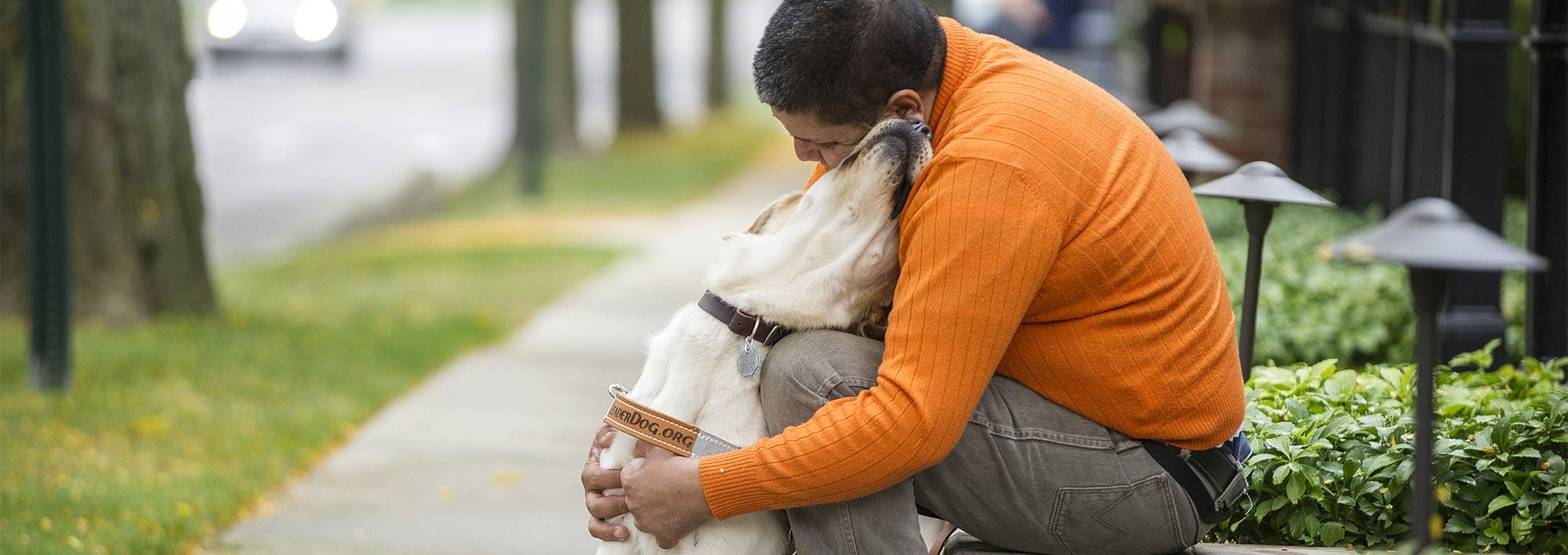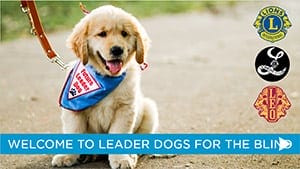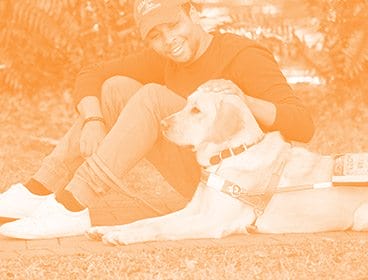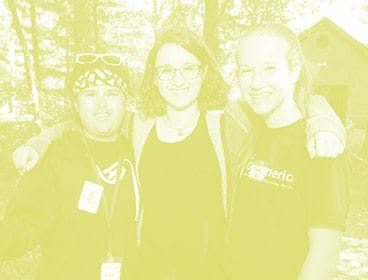
Lions Resources
Spread Our Message. Change Lives.
Leader Dog’s mission would not be possible without your commitment to our organization. To sustain our efforts for years to come, it is important for more people to know about Leader Dog. Our goal is for everyone who encounters us to understand:
- Our mission
- What we stand for
- Why we matter
- How we do what we do better than anyone
Together, we need to communicate a consistent message to family, friends and the surrounding communities. The kind of message that sparks a conversation, ignites passion and motivates people to take action.
As a result, Leader Dog will be able to continue to impact the lives of people who are blind or visually impaired, extend our outreach to new areas and build a bigger community of supporters.
Downloadable Materials


Client Stories
Leader Dog Fast Facts
Mission
Our mission is empowering people who are blind or visually impaired with lifelong skills for safe and independent daily travel.
Programs
Every year, we match 200 people with Leader Dogs, provide 100 people with orientation and mobility training, teach 24 teens leadership and travel skills, pair 6 people who are both deaf and blind with Leader Dogs, and pass on $0 of the cost of these services to our clients.
Funding
Leader Dog operates entirely on donated funds. The continued success of the our programs depends on the generosity of our contributors and community funding sources around the world.
History
Leader Dog was founded in 1939 by three members of a Detroit-area Lions club who were unable to obtain a guide dog for a friend from any other source. The trio led the purchase of an old farmhouse in Rochester Hills, Michigan to house the training facilities. Since then, we have raised, trained and graduated more than 14,500 Leader Dogs.
Affiliation
We are a private, nonprofit agency. Though we are not affiliated with Lions clubs, Lions are a major part of our history and remain a significant part of our support and success.
- There are currently over 1.1 million people who are blind and partially sighted in the U.S. alone who can become more independent if they receive mobility training.
- 200 Leader Dogs and clients are matched every year.
- Leader Dogs for the Blind was incorporated in 1939 and our first class consisted of four people.
- Today, Leader Dog runs 12 guide dog sessions per year with up to 24 clients in each class.
- Most guide dog clients attend our three-week on-campus program. Some clients receive home-delivered dogs and training to accommodate time and travel limitations.
- Dogs are trained for four months prior to being matched with a client. Dogs for clients who are both deaf and blind receive extended training.
- There are more than 14,500 graduates in 49 states, 7 provinces and 31 countries.
- Utilities to maintain the residential program cost about $430,000 annually.
- The 65,000 square foot kennel space houses up to 315 dogs.
- The average inventory of dogs requires in excess of 122,000 pounds of dog food annually.
- The Leader Dog food service team prepares approximately 170 meals per day and uses 2,000 dozen eggs, 1,800 pounds of beef, 3,000 pounds of chicken and 1,200 loaves of bread annually.
- Our DeafBlind program was established in 1991. It was created by a Leader Dog team member who recognized the need; he is recognized nationally as a pioneer in this field.
- On average, six people who are DeafBlind graduate each year. Nearly 100 people have graduated from the program since its inception in 1991.
- Leader Dogs for the Blind has two instructors who communicate with clients in tactile American Sign Language (“reading” hands are gently placed over “speaking” hands to feel the sign language).
- Leader Dogs in this program are trained to understand and respond to both verbal commands and sign language hand signals.
- Leader Dogs prepared for DeafBlind clients receive up to six months of training (as compared to four months for “standard” Leader Dog training).
- Leader Dogs assigned to DeafBlind clients are hand-picked by the specialized instructors. These dogs are chosen for appropriate attention to the handler and their ability to assume a greater amount of responsibility.
- Deaf-Blind clients complete a three-week on-campus training program at Leader Dogs for the Blind. The client to instructor ratio is 1:2 (as compared to 1:6 for “standard” class).
- During class, clients learn how to care for and communicate with their Leader Dog. Clients learn how to travel safely with their new partner as a Leader Dog team.
- In 2002, Leader Dog began offering our free Orientation and Mobility (O&M) Training program for adults wishing to quickly improve their travel skills.
- The program was created when Leader Dog employees recognized that many prospective guide dog clients were being turned away because they did not have sufficient O&M skills to navigate successfully with a guide dog.
- Clients who take part in our O&M program do not have to be planning to get a guide dog. About 50% of O&M clients return to get a Leader Dog.
- The O&M program one week long. It was originally designed to aid in rapid improvement of cane mobility skills without a lengthy disruption to clients’ lives.
- The training covers many areas of O&M including:
- Using a white cane
- Utilizing a human guide
- Using your orientation skills and cardinal directions (north, south, east, west) to know where you are, where you want to go, and how to get there
- Solving problems along your route (barriers, crowds, etc.)
- Crossing both narrow and wide streets safely
- Re-orienting yourself, or “what to do when you get lost”
- Shopping, soliciting assistance when needed, and more
- Clients train in a wide variety of environments that they experience in daily life such as residential, semi-business, business, city and country settings.
- 80% of training takes place outdoors and 20% is completed indoors learning how to navigate things like elevators, escalators and moving sidewalks.
- Like our Guide Dog Training program, O&M Training is a residential program, so clients live on our campus in Rochester Hills, Michigan during the week of training.
- Teen Summer Camp is our residential summer program for 16- and 17-year-olds. It's headed by our team of certified orientation and mobility specialists.
- Campers stay at our beautiful campus in Rochester Hills, Michigan and enjoy day trips in the surrounding area.
- Our facility includes a dining room, large screen television room, music room, library with accessible books and movies, outdoor pavilion and 24/7 Leader Dog staff. Each camper’s private room is complete with a bathroom, television, telephone, internet access and mini refrigerator.
- All Teen Summer Camp attendees receive a free GPS device and instruction in how to use it.
- Campers practice using GPS as they complete many fun activities that have included tandem biking, kayaking, yoga, scavenger hunts and much more.
- Campers have the opportunity to experience working with a Leader Dog. For many campers, this is their first time navigating with a guide dog.
- Leader Dog pays for all costs associated with the program including travel to and from Leader Dog's campus, the GPS device, housing, meals, activities and related training.
- Staffed with two full-time veterinarians and two veterinary technicians
- Approximately 30 physicals are performed each day
- 50–60 x-rays are taken each week
- 450–500 spays and neuters are performed each year
- State-of-the-art equipment is used, e.g.:
- Ultrasound: for imaging internal structures of the abdomen and for pregnancy diagnosis
- Laser: for soft tissue surgery to decrease pain and provide for bloodless surgery
- Digital radiograph unit: for enhanced detail and image manipulation of radiographs and to increase efficiency in diagnosis of medical conditions
- Digital dental radiology: for greater detail and image enhancement in dental care
- Endoscope: for noninvasive gastrointestinal (GI) care and artificial inseminations
- Advanced dental care is provided, including root canals, pulp caps (alternative to root canal), orthodontic appliances and surgery
- Care is provided for:
- Breeding
- Birthing (whelping)
- Puppies
- Leader Dogs in training
- Working Leader Dogs
- Veterinarians are able to perform 95% of the required medical care at the Leader Dog clinic. Referrals and consultations with area veterinary specialists are available.
- 80% of the dogs bred at Leader Dogs for the Blind are Labrador retrievers. Labs work well as Leader Dogs due to their:
- Size: small, easy fit in vehicles
- Coat: easy care, double-coated for cold and heat protection
- Relaxed temperament, eagerness to learn and work
- 10% of the dogs bred at Leader Dogs for the Blind are golden retrievers. Goldens work well as Leader Dogs due to their:
- Size: small, easy fit in vehicles
- Coat: requires minimal grooming, double-coated for protection
- Loving and eager personality
- Less than 5% of the dogs bred at Leader Dogs for the Blind are German shepherd dogs. German shepherds work well as Leader Dogs due to their:
- Size: medium build, capable of long strides
- Coat: easy care, double-coated for protection
- Strong work ethic, alertness and eagerness to learn
- 5% of the dogs bred at Leader Dogs for the Blind are Labrador/golden retriever crosses.
- Breeding stock dogs are housed by volunteers in their homes.
- Breeding stock dogs are selected for our program based on their history, health and temperament. We select dogs that have the potential to be excellent Leader Dogs.
- Puppies are born in the volunteer homes that host the female breeding stock.
- Host families will care for the litter of puppies for six weeks before coming to Leader Dogs for the Blind to be examined by veterinarians and placed with a volunteer puppy raiser.
- Leader Dogs for the Blind has a cryogenics lab where we freeze or chill semen and have stored approximately 60 different stud dogs.
- Leader Dogs for the Blind’s breeding program is overseen by a committee comprised of six staff members including veterinarians, puppy development, breeding manager and guide dog instructor. This committee also consults with geneticists, breeders and reproductive specialists.



